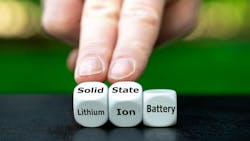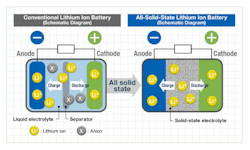Conductive All-Solid-State Battery Stores Ions and Self-Heals
What you’ll learn:
- Lithium-iron-chloride cathodes help deliver next-generation all-solid-state batteries that are energy-dense, durable and self-healing.
- While liquid electrolyte designs introduce electrical bottlenecks and interface degradation, all-solid-state batteries maximize energy storage, sustain high-rate operation, and resist mechanical degradation.
- The material is fast charging, has reasonable capacity, and uses inexpensive and abundant raw materials.
- The biggest drawback is the manufacturing process, as it's hard to scale the pulverization process used in the lab.
There are plenty of reasons to believe solid-state batteries (SSBs) will take a big step forward this year. Unlike today’s Li-ion chemistry being used in electric vehicles, which employ liquid electrolytes with low operating temperature limits, SSBs have high operating temperature limits and excellent fast-charging performance. They promise improvements in range, charging time, and safety compared to current lithium-ion batteries.
Conventional SSB approaches typically resort to composite architectures blending active materials, conductive additives, and solid electrolytes, with one substance used to allow ions into and out of the electrode, another to store them, and sometimes a third to provide high conductivity. Unfortunately, these designs introduce electrical bottlenecks and interface degradation. This leads to a breakdown at the interfaces between materials, degrading the battery's capacity, and reducing cycle life and energy density gains.
Solid-state batteries, on the other hand, require advanced cathode designs to realize their potential for high energy density and economic viability. However, they’re hindered by materials lacking sufficient conductivity, mechanical robustness, and structural stability. Recent lab research aims to identify the expected positive effect exerted by an integrated all-in-one cathode, eliminating inactive conductive additives and heterogeneous interfaces.
A New SSB Direction: Lithium Iron Chloride
A team of researchers is studying a material comprised of readily available elements that allows lithium ions to move freely and then find storage sites. On top of that, like the cherry on a sundae, their material allows for self-healing, fixing damage that may take place during charging/discharging cycles.
Jiamin Fu, Changhong Wang, and Shuo Wang of the University of Western Ontario, London, Ontario, Canada and their colleagues realized that conventional composite cathode designs, which typically incorporate a cathode active material and an electronic conducting additive, are often limited by the amount of electrochemically inactive components required.
In the June 25, 2025 edition of Nature, they published a paper showing that a lithium-iron-chloride halide cathode material cleverly navigates these longstanding challenges.
The researchers found that Li1.3Fe1.2Cl4 had a variable number of lithium atoms in its structure. Thus, lithium ions could rapidly move between locations, as well as give the ions a place to be stored.
Making it involved creating a mix of crushed lithium chloride and two different formulations of iron chloride, mixing via rapid rotation and heating at 200°C.
Test Results
When put to use in a test setup, the material had a similar energy density to iron-phosphate cathodes. What was unusual is the material maintained more of its capacity when charging at higher rates—typically, most materials do better at a slower rate of charge. And it was quite durable, retaining over 90% of its capacity after 3,000 cycles when charged and discharged at a rate of 5 C, a rate that would fill a battery in less than 15 minutes.
The researchers further found they could improve the material's conductivity by mixing in some conductive carbon (about 2% by weight). In addition, they showed that it could be layered on top of a high-capacity cathode material, acting as a solid-state electrolyte that both enables ions to flow through and stores them if the capacity of the cathode material is saturated.
The materials under test went through phase transitions during the charging cycle. As more of the lithium left the structure, the position of the iron relative to the chlorine shifted and the melting point changed. This may have contributed to a change in the material's properties, creating different phases during the full cycle. Overall, the material expanded by about 8% as it filled up with ions during charging.
In solid-state batteries, rigid interfaces often succumb to mechanical and chemical degradation under the demanding conditions of fast cycling, a chief culprit in loss of capacity. Here, the melting-point changes combined with the heat associated with charge/discharge sparked a transition from brittle to ductile.
That, in turn, made the material self-healing, effectively mitigating crack formation and eliminating voids present in the Li1.3Fe1.2Cl4 electrode, which were completely healed upon charging. As a result, this cathode material was said to hold onto 90% of its capacity after the equivalent of 10 years of daily charging.
The authors demonstrated that Li1.3Fe1.2Cl4 attained an initial electrode energy density of 529.3 Wh/kg relative to a Li⁺/Li reference material, which surpasses the performance of many existing cathodes. Integration with a nickel-rich layered oxide further increased the energy density to 725.6 Wh/kg.
This research paves the way for designing cathodes that can simultaneously maximize energy storage, sustain high-rate operations, and resist mechanical degradation, as well as trim battery cost. However, further research and development are needed to refine the manufacturing process.

